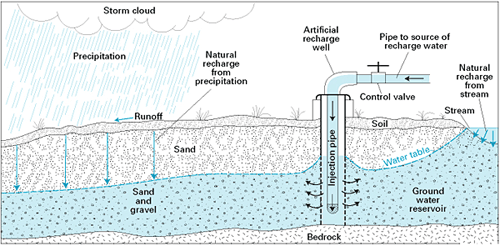Groundwater is the most abundant source of freshwater for drinking and irrigation. It is a renewable resource that is stored in underground reservoirs (aquifers) and replenished by precipitation. Withdrawing groundwater faster than it is replenished is unsustainable. Excessive pumping of groundwater cannot only cause a water-supply problem, but can also result in land subsidence or, in coastal areas, saltwater intrusion. Because natural replenishment by precipitation infiltration is such a slow process, groundwater recharge by injection or infiltration (spreading water over land) of stormwater runoff or treated wastewater is becoming increasingly important in water-stressed regions. See also: Aquifer; Groundwater hydrology; Hydrology; Irrigation (agriculture); Precipitation (meteorology); Wastewater reuse

By 2025 1.8 billion people will be living with water scarcity (lack of supply) and two-thirds of the world could be living with water stress (demand in excess of supply), according to the United Nations. Freshwater availability will particularly be a problem if drought becomes more frequent as a consequence of global warming. The U.S. Government Accountability Organization (GAO) reported that in the United States alone, 40 of 50 state water managers expect shortages by 2023. Researchers from University of Twente in the Netherlands paint an even bleaker picture, as they reported that worldwide 4 billion people are already experiencing water scarcity for one or more months per year. See also: Drought; Hydrological consequences of global warming
Compared to water desalination or surface-water storage in reservoirs, groundwater recharge is a relatively low-cost means of mitigating water scarcity. For supply, however, it does require energy (a cost) to pump the water from aquifers. There are environmental considerations as well. For example, farmland over which water is spread should be relatively free of pesticides, fertilizers, and other agricultural chemicals to avoid passing those contaminants into reservoirs. Also, treated wastewater should be free of human pathogens, metals, and trace organic compounds. See also: Agriculture; Water desalination; Water pollution; Water resources; Water supply engineering; Water treatment





